Difference between revisions of "Japanese Theorem"
Shalomkeshet (talk | contribs) (Tag: Undo) |
m (Stub) |
||
| (2 intermediate revisions by 2 users not shown) | |||
| Line 1: | Line 1: | ||
| − | The '''Japanese | + | The '''Japanese Theorem''' is a theorem which holds for [[cyclic polygon]]s. |
| − | == | + | == Statement == |
| + | For any triangulated cyclic polygon, the sum of the [[Inradius|inradii]] of the triangles is constant. | ||
| − | == | + | == Japanese Theorem for cyclic quadrilaterals == |
| − | |||
| + | === Statement === | ||
| − | [[ | + | The '''Japanese theorem for cyclic quadrilaterals''' states that for a cyclic quadrilateral <math>ABCD</math> and [[incenter]]s <math>M_1</math>, <math>M_2</math>, <math>M_3</math>, <math>M_4</math> of triangles <math>\triangle ABD</math>, <math>\triangle ABC</math>, <math>\triangle BCD</math>, <math>\triangle ACD</math> the quadrilateral <math>M_1M_2M_3M_4</math> is a [[rectangle]]. |
| − | |||
| − | |||
| − | < | + | [[File:japanese_theorem_quadrilaterals.png|300px|thumb|left]]<!--Please Asymptote--> |
| − | + | === Proof === | |
| − | |||
| − | |||
| + | From <math>\triangle ABC</math>, we can see that | ||
| + | <cmath>\angle BM_2C = 90^{\circ} + \frac{1}{2} \angle CAB</cmath> | ||
| + | and similarly, from <math>\triangle BCD</math> we have | ||
| + | <cmath>\angle BM_3C = 90^{\circ} + \frac{1}{2} \angle CDB</cmath> | ||
Since <math>ABCD</math> is cyclic, therefore <math>\angle CDB = \angle CAB</math>, which means that | Since <math>ABCD</math> is cyclic, therefore <math>\angle CDB = \angle CAB</math>, which means that | ||
| − | + | <cmath>\angle BM_2C = \angle BM_3C</cmath> | |
| − | < | ||
| − | |||
From this, it follows that <math>BM_2M_3C</math> is cyclic. This means that | From this, it follows that <math>BM_2M_3C</math> is cyclic. This means that | ||
| − | + | <cmath>\angle BCM_3 + \angle BM_2M_3 = 180^{\circ}</cmath> | |
| − | < | ||
| − | |||
By symmetry, we can also derive | By symmetry, we can also derive | ||
| − | + | <cmath>\angle BAM_1 + \angle BM_2M_1 = 180^{\circ}</cmath> | |
| − | < | + | Adding these equations, we get |
| − | + | <cmath>\angle BAM_1 + \angle BCM_3 + \angle BM_2M_1 + \angle BM_2M_3 = 360^{\circ}</cmath> | |
| − | Adding these equations | + | <cmath>\implies \angle BM_2M_1 + \angle BM_2M_3 = 360^{\circ} - \angle BAM_1 - \angle BCM_3 = 360^{\circ} - \frac{1}{2} \left(\angle CAB + \angle CDB \right)</cmath> |
| − | |||
| − | < | ||
| − | |||
| − | < | ||
| − | |||
Which implies | Which implies | ||
| + | <cmath>M_1M_2M_3 = 90^{\circ}</cmath> | ||
| − | + | And other angles similarly. <math>\square</math> | |
| − | |||
| − | And other angles similarly. | ||
| − | |||
| − | <math> | ||
| − | |||
| − | |||
| − | |||
| − | |||
| − | + | {{stub}} | |
| − | |||
Latest revision as of 09:46, 11 April 2025
The Japanese Theorem is a theorem which holds for cyclic polygons.
Statement
For any triangulated cyclic polygon, the sum of the inradii of the triangles is constant.
Japanese Theorem for cyclic quadrilaterals
Statement
The Japanese theorem for cyclic quadrilaterals states that for a cyclic quadrilateral ![]() and incenters
and incenters ![]() ,
, ![]() ,
, ![]() ,
, ![]() of triangles
of triangles ![]() ,
, ![]() ,
, ![]() ,
, ![]() the quadrilateral
the quadrilateral ![]() is a rectangle.
is a rectangle.
Proof
From ![]() , we can see that
, we can see that
![]() and similarly, from
and similarly, from ![]() we have
we have
![]() Since
Since ![]() is cyclic, therefore
is cyclic, therefore ![]() , which means that
, which means that
![]() From this, it follows that
From this, it follows that ![]() is cyclic. This means that
is cyclic. This means that
![]() By symmetry, we can also derive
By symmetry, we can also derive
![]() Adding these equations, we get
Adding these equations, we get
![]()
![]() Which implies
Which implies
![]()
And other angles similarly. ![]()
This article is a stub. Help us out by expanding it.










